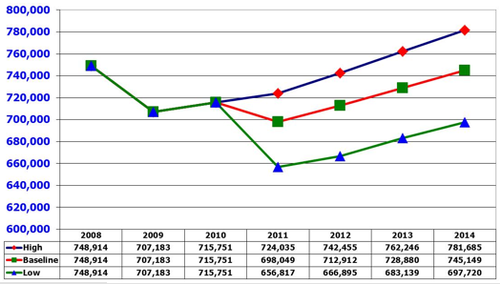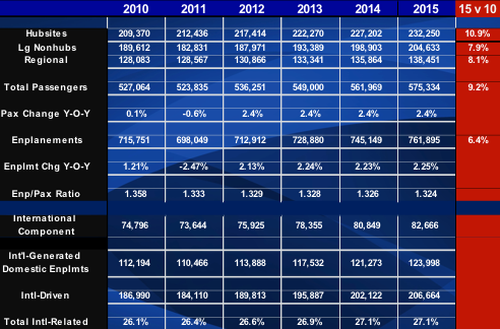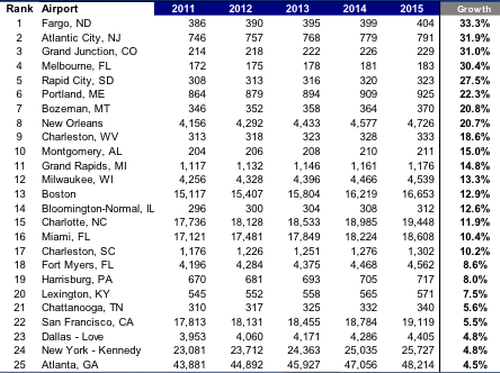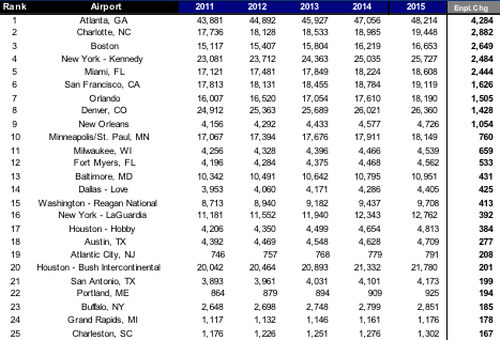Canada to become global portal at US expense
The US requirement that passengers transiting US hubs must get a visa to enter the US is stifling the ability of US global carriers to compete, leaving the door wide open for Canadian airports to become global portals for passengers transiting from the US and Latin America to Europe and Asia, according to Boyd Group International President Micheal Boyd, who has released his global forecasts.
What makes his statement interesting is the fact that Air Canada has long been reporting that it is poaching Asia and Europe-bound traffic from the US international hubs. Indeed, COPA Holdings Vice President Commercial and Planning Joe Mohan pitched his Panama City hub as a transit point, saying it was the number one free-trade zone in the world. He added that, beyond the inconvenience factor in obtaining a visa, it is cost prohibitive in the Asian and Latin American markets. Boyd agrees saying the rule was just plain dumb. Indeed, he indicated that it will affect what oneworld is attempting to do with new the new Madrid-Miami service.
"For US hubs to become global portals they have got to change that rule or they risk falling further behind," he told attendees at the 15th annual International Aviation Forecast Summit that draws aviation luminaries from around the world. "A perfect example is Sao Paulo-Hong Kong. You could go to Atlanta or Dallas where you need a visa to sit in a sterile holding area at the airport or you can go over Canada."
Mohan said trade between Asia and Latin America has more than quadrupled as he predicted the next big alliance fight will be over the passengers produced by the LAN and TAM deal which is currently split between oneworld and Star, respectively. "Star has a big hole," he said. "There are so many countries where they have no presence so they will be aggressive in trying to attract that traffic. The big question is whether SkyTeam, with only Aerolineas Argentina, will be picking up the pieces and be shut out. If oneworld can win LAN/TAM, that will be a powerful combination over Miami."
Mohan noted Panama City was the only hub due south of Miami and could be used to connect underserved markets in Latin America. In fact, he called the 787 a game changer in the Latin-Asia market which could open up Panama "big time". Even so, Copa was built on a simplified business model that probably couldn't withstand that added level of complexity of widebodies. "It's more what I would like to see ANA do in serving Panama as a transit point to Latin America," he said, adding Panama does not require a transit visit. "Maybe Air New Zealand. Someone will definitely do it."
Even so, Boyd did say numerous US hubs had the potential to become global portals, including Dallas for Latin America along with Houston and Miami. Chicago would be strong for Europe and Asia as would Detroit. But Atlanta is positioned for all four regions: Europe, Asia, Latin American and the Caribbean. "The constraining factor is US visa policy which also affects Canadian citizens transiting US hubs," he said.
In Canada the global portals could be Toronto, Calgary, Vancouver and Montreal but most likely Toronto and Vancouver. He cited the mileage between Sao Paolo and Shanghai, noting the shortest was via Dubai or London at nearly 19,000 miles. Those in North America were between 19,000 and 20,000 miles, making them viable alternatives to the Middle East or Europe.
Boyd also called the Canadian market one of the best kept secrets in the industry. "Everyone talks about China," he said, "but what they forget is Canada and US combined is formidable. We have to stop thinking in terms of a US market and a Canadian market and understand this truly is a North American market."
He pointed to the increasing cooperation between US and Canadian carriers citing the United-Air Canada joint venture as well as the American Airlines deal with WestJet. Boyd said the potential of the American-WestJet deal is huge, especially if WestJet eventually begins to codeshare with the Dallas-based carrier. "You will get flows through both systems and that is going to be positive for everyone," he concluded.
Star Alliance is the best positioned in the Canadian market with Air Canada having 54% of the seats in the Vancouver market, 66% of the Toronto market, 47% of the Calgary market and 61% of the Montreal market. SkyTeam's biggest presence in Canada is 10% at Montreal while oneworld's is over Vancouver with 8%. Still, large unaligned market share exist with 35% in Vancouver, 48% in Calgary and 22% each in Toronto and Montreal.
In addition, the factors affecting the trans-border flows include the fact that Air Canada has no narrowbody aircraft on order and United's narrowbody order has been postponed indefinitely until its merger with Continental is further along. WestJet, on the other hand is takng 40 new 737s between 2010 and 2016, half of which will come over the next three years.
"WestJet's growth in recent years has been to sunshine markets, Caribbean, Hawaii and Mexico," he said.
He also cited the communities of interest that are building between the US an Canada including the Canadian energy sector and that in the Rocky Mountains in the US. "The energy sector drives disposable income growth," he said. "There is also strong 'snowbird' traffic southbound in the winter and peak northbound traffic in the summer."
Boyd indicated the fight currently brewing at the Toronto Island Billy Bishop Airport was one of the more interesting trans-border developments. "Porter is offering 41,000-plus trans-border seats now," he said. "Air Canada starts service at YTZ in February using five Q400s operated by SkyService. Then Continental/United has 16 slots at YTZ and will likely use them for Newark and Chicago."
Boyd added the trans-border service doesn't even count the border crossings by Canadians to avoid increasing taxes and fees charged at Canadian airports. He noted the Montreal-Orlando base fare was USD159.83 but USD232.98 with taxes and fees. But, the Burlington, VT-Orlando base fare was USD169.60 including taxes and fees. "The difference in the base fares is 8.1% while the difference in the total price is 37.3%, that is what is driving Canadians across the border to Spokane, Seattle, Bellingham, Great Falls, Traverse City, Buffalo, Syracuse, Burlington and Bangor. The Canadian's desire to tax their passengers to oblivian is really helping border airports across the US."
Boyd Group International forecast the trans-border traffic will jump 7% over the next three years to nearly 30 million seats and 20 million passengers. Key variables, said Boyd, included the GDP stagnation over the next three years both north and south of the border and the fact it is unlikely traffic growth will keep pace with the capacity growth.
"Trans-border load factors historically have been around 70% which is well below the US domestic averages," he said. "Toronto Island load factors lag the average at about 50%. There is some mitigation, however, due to transit flow passengers. And then there is the minimal narrow-body fleet on both sides of the border."
Hubs will grow further, small airports will lose out
Small regional airports will be losing commercial air service in the US over the next half decade unless nearby regional airports become regional transportation centres, said Boyd. It is just a matter of time before small airports lose their service, something they are loathe to give up. Thus transforming themselves into more powerful regional centres will at least retain air service to the region, especially for cities that are close to one another.
Boyd's traffic forecast defines hubsites as airports with dedicated resources to inter-connect passengers, while large non-hubsites, are the large metro airports where no airline predominantly inter-connects passengers.
Mega-carrier systems and alliances will become more important than ever, said Boyd of emerging trends. "Alliance contribution trumps national," he said. "Pooling international lift through joint ventures will continue while there will be a major reduction in the leased-in regional jet service. There will be a reduction in off-hub flying such as Boston-San Francisco where, for the first time in history, American was driven out by low-cost carrier JetBlue. That will be a one off, I think, though."
Interestingly, he said that the merger trends will result in enhanced, not reduced, capacity, despite presumptions that the synergies will ultimately reduce capacity. Boyd noted that both United and Delta are spending their synergies on increasing capacity. Joining them are WestJet and JetBlue, both with "frisky growth".
"United woke up, finally," he said. "It has been asleep at the switch for several years," he said. "It is now being run by Continental executives who are going after Southwest at Denver. They are awake and whenever you have a fight the only winner is the consumer."
Boyd cautioned communities should no longer be thinking in terms of retaining air service so much as they should be thinking about maintaining access to the world. "There will be a consolidation of the feed systems which will mean fewer markets accessed locally," he said. "The key factor is keeping regional access to and from the rest of the globe.
He predicted 2011 will be very uncertain because of the recovery is bouncing along the bottom. However, he said passenger enplanements will rise from the 748,914 in 2008 to 781,685 by 2014. He pointed out the low came in 2009 at 707,183 which will rise to 715,751 in 2010. "That's the high scenario," he said. "The baseline has passenger enplanements rising to 745,149 in 2014 while the low sees enplanments continuing to drop down to 656,817 next year and then recovering to only 697,720 by 2014."
Airports: US enplanement forecast 2011-2015
Boyd is convinced the record earnings posted in the third quarter will not be squandered on chasing market share. "There will be limited capacity expansion in 2011 because the economic tea leaves are not good," he said. "In fact, this may be the eye of the storm. We may be headed into the wall shortly. There will be a rebound but that is based on the assumption the recession will end. Airline strategies are now based on revenue, not volume. Besides Delta and United, the rest of the majors are very conservative so you can expect capacity in the first quarter 2011 to be at or below 2010."
Schedule comparison: select carrier systems
Summary
He also pointed out that, contrary to popular belief that mainlines were abandoning the domestic market, domestic has become a much more integral piece of the pie given the fact that a lot of new international markets would fail were it not for the feed. Indeed, American recently noted when it announced the expansion of its Los Angeles hub that it had twice tried LAX-Shanghai and failed but its new cornerstone strategy, plus the new feed service to various new points, along with its British Airways/Iberia joint business changes the game.
"International travel generates additional domestic enplanements," he said. "London-Detroit generates over 70,000 connect enplanements plus additional segments flown beyond the hub by international passengers.
International and domestic flows
Also contrary to conventional wisdom, said Boyd, was the top 25 growth airports in the US. Hubs such as Kennedy and Atlanta were near the bottom at 4.8% and 4.5%, respectively. It is small down, America that is growing with Fargo, ND, growing 33.3% over the five-year forecast period, thanks in large measure to energy exploration. Boston, now becoming a larger presence in the JetBlue system, is expected to grow 12.9% while Miami will grow 10.4%.
"JFK has been rediscovered," he said. "Historically, it always was an international connecting hub but now you have three airlines fighting over the local New York metropolitan traffic, United at Newark and Delta and American at Kennedy. It is that local traffic that is very lucrative."
Top 25 growth airports - 2015 v 2010. Enplanements
Top 25 enplanement airports - 2015 v 2010
Despite predictions that Southwest's entrance into Atlanta would be a game changer, Boyd did not think so. "Everybody talks about the Southwest effect, but Atlanta has had the AirTran effect," he said. "I think the merger will be very good, but I just don't see things changing that much. In the top 25 O&D markets AirTran already had lower fares and its costs and fares are lower than Southwest. Delta, however, must have been happy when he heard Southwest will get rid of business class, because that will all go back to Delta. Every market where Delta and AirTran compete you will see higher load factors, higher yields and lower gauge aircraft from Delta. It's a rare situation for a merger to make everyone happy. A sidebar to all this is the fact that 67% of AirTran traffic connects at Atlanta meaning Southwest will have to adjust to being a hub carrier. It has always had hubs and connecting traffic. It just needs to formalize it now and adjust to becoming a full-blown banked airport. Otherwise you can't just randomly connect passengers and get the kind of feed traffic AirTran enjoys."
Boyd, pointed to Charlotte saying it will grow at double digit rates and could see "explosive" growth because of the connections US Airways is building over that hub, adding that Philadelphia still had a lot of growth potential for the same reason. He said the most volatile airports remain Cincinnati but reminded the audience that, for the first half of the year, it was the fastest growing O&D market in the country with declining traffic only coming from the flows that used to connect to Delta. He suggested it would begin to take traffic from Dayton now that Delta has lowered the fares.
Boyd also said Milwaukee remains uncertain, doubting it would become a connecting hub for Southwest because the Dallas-based carrier already has Midway in the same region. "Everyone predicted that Delta would close Memphis," he said. "Nonsense. It is a huge access point for the deep south which has become an industrial belt. Delta just announced Memphis-Mexico City. Think textiles."
Top 25 Airports Ranked By Enplanement Increase






